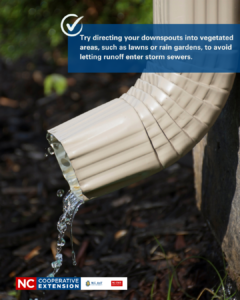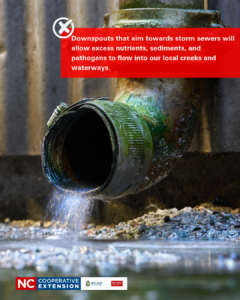Stormwater 101 – Noticing the Small Things
go.ncsu.edu/readext?1064073
en Español / em Português
El inglés es el idioma de control de esta página. En la medida en que haya algún conflicto entre la traducción al inglés y la traducción, el inglés prevalece.
Al hacer clic en el enlace de traducción se activa un servicio de traducción gratuito para convertir la página al español. Al igual que con cualquier traducción por Internet, la conversión no es sensible al contexto y puede que no traduzca el texto en su significado original. NC State Extension no garantiza la exactitud del texto traducido. Por favor, tenga en cuenta que algunas aplicaciones y/o servicios pueden no funcionar como se espera cuando se traducen.
Português
Inglês é o idioma de controle desta página. Na medida que haja algum conflito entre o texto original em Inglês e a tradução, o Inglês prevalece.
Ao clicar no link de tradução, um serviço gratuito de tradução será ativado para converter a página para o Português. Como em qualquer tradução pela internet, a conversão não é sensivel ao contexto e pode não ocorrer a tradução para o significado orginal. O serviço de Extensão da Carolina do Norte (NC State Extension) não garante a exatidão do texto traduzido. Por favor, observe que algumas funções ou serviços podem não funcionar como esperado após a tradução.
English
English is the controlling language of this page. To the extent there is any conflict between the English text and the translation, English controls.
Clicking on the translation link activates a free translation service to convert the page to Spanish. As with any Internet translation, the conversion is not context-sensitive and may not translate the text to its original meaning. NC State Extension does not guarantee the accuracy of the translated text. Please note that some applications and/or services may not function as expected when translated.
Collapse ▲-Article provided by Extension Associate, Amber Ellis
Engineering is all around us, but the average person rarely thinks about it. When commuters cross bridges on the way to work, there’s no need for them to think of structural engineering calculations. When I text a friend, I never consider the electrical engineering feats that make up my tiny pocket computer. Even when I do stop to appreciate the workmanship that makes modern life possible, there’s not much I can offer beyond admiration. Stormwater is different, however, in that it offers the opportunity for anyone to partner in addressing problems engineers seek to solve. Together, we can improve our community; all we need is a little background knowledge:
Urbanization transitions landscapes from natural, permeable surfaces to constructed, impermeable ones. For example, landscapes that were once forests or meadows may now be neighborhoods or schools. When it rains, precipitation that would have infiltrated into the soil is redirected by these new roads and rooftops as runoff. Runoff can increase the risk of local flooding and transport pollutants such as sediment and nutrients into local waterways.
The United States Environmental Protection Agency has named this nonpoint source pollution one of the leading causes of water quality impairment, and it has far-reaching impacts, including habitat destruction and human drinking water hazards. Stormwater control measures are engineered systems, such as ponds, that are designed to mitigate stormwater runoff impacts. Stormwater engineers spend most of their time and energy creating these systems to treat large parcels and entire developments.
While these systems provide necessary treatment, they aren’t our only stormwater tool. Individual homeowners, residents, and community groups can tackle the problem at the source. Simply directing downspouts from your home away from driveways and toward vegetated areas can reduce runoff by 30-85%! Similarly, rain gardens and rain barrels can reduce runoff, intercepting it before it accumulates pollutants or raises creek levels. Even an act as small as picking up your pet waste can have drastic effects on reducing local pollutant loads. So, while you won’t be designing ponds anytime soon, the next time it rains, see if you can notice where the water is headed and if there’s anything you can do to help.






